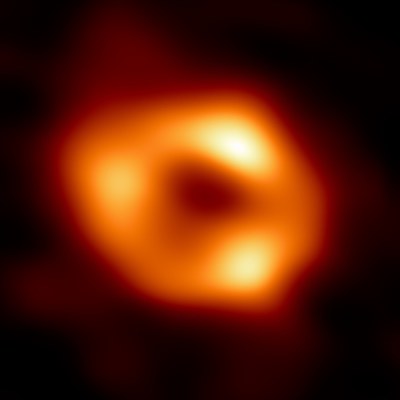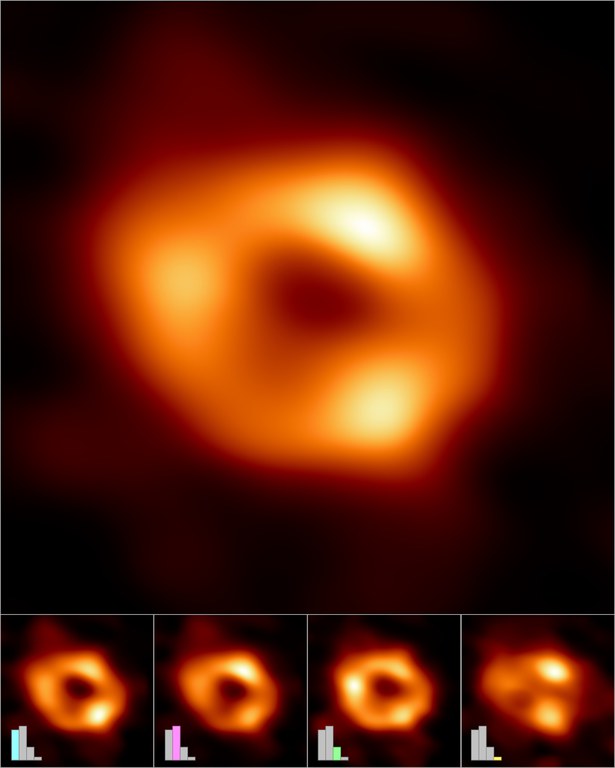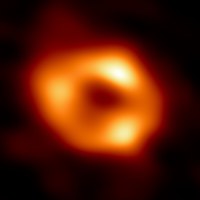First image of the black hole at the heart of the Milky Way
Astronomers have unveiled the first image of the supermassive black hole at the centre of our own Milky Way galaxy. This result provides overwhelming evidence that the object is indeed a black hole and yields valuable clues about the nature of such giants, which are thought to reside at the centers of most galaxies. The image was produced by a global research team called the Event Horizon Telescope (EHT) Collaboration, using observations from a worldwide network of radio telescopes.
The black hole image is a long-anticipated direct look at the massive object that resides at the very centre of our galaxy. Scientists, awarded by the Nobel prize, had previously seen stars orbiting around something invisible, compact, and very massive at the centre of the Milky Way. This strongly suggested that this object — known as Sagittarius A* (Sgr A*, pronounced "sadge-ay-star") — is a black hole, and today’s image provides the first direct visual evidence of it.
Although we cannot see the black hole itself, because it is completely dark, glowing gas around it reveals a tell-tale signature: a dark central region (called a “shadow”) surrounded by a bright ring-like structure. The new view captures light bent by the powerful gravity of the black hole, which is four million times more massive than our Sun.
“We were stunned by how well the size of the observed ring agrees with predictions from Einstein’s Theory of General Relativity”, says EHT Project Scientist Geoffrey Bower from the Institute of Astronomy and Astrophysics, Academia Sinica, Taipei. “These unprecedented observations have greatly improved our understanding of physical processes in galactic centers, and offer new insights on how these giant black holes interact with their surroundings.” The EHT team's results are being published today in a special issue of The Astrophysical Journal Letters.
Because Sgr A* is about 27,000 light-years away from Earth, it appears to us to have about the same size in the sky as a donut on the Moon. To image it, the team created the powerful EHT, which links together eight existing radio observatories across the planet to form a single “Earth-sized” virtual telescope. The EHT observed the black hole on multiple nights, collecting data for many hours in a row, similar to using a long exposure time on a camera.
The breakthrough follows the EHT collaboration’s 2019 release of the first image of a black hole, called M87*, at the centre of the more distant galaxy Messier 87.
The two black holes look remarkably similar, even though our galaxy’s black hole is more than a thousand times smaller and less massive than M87*. "We have two completely different types of galaxies and two very different black hole masses, but close to the edge of these black holes they look amazingly similar,” says Sera Markoff, Co-Chair of the EHT Science Council and a professor of theoretical astrophysics at the University of Amsterdam, the Netherlands. "This tells us that General Relativity governs these objects up close, and any differences we see further away must be due to differences in the material that surrounds the black holes.”
This achievement was considerably more difficult than for M87*, even though Sgr A* is much closer to us. EHT scientist Chi-kwan (‘CK’) Chan, from Steward Observatory and Department of Astronomy and the Data Science Institute of the University of Arizona, US, explains: “The gas in the vicinity of the black holes moves at the same speed — nearly as fast as light — around both Sgr A* and M87*. But where gas takes days to weeks to orbit the larger M87*, in the much smaller Sgr A* it completes an orbit in mere minutes. This means the brightness and pattern of the gas around Sgr A* was changing rapidly as the EHT Collaboration was observing it — a bit like trying to take a clear picture of a puppy quickly chasing its tail.”
The researchers had to develop sophisticated new tools that accounted for the gas movement around Sgr A*. While M87* was an easier, steadier target, with nearly all images looking the same, that was not the case for Sgr A*. The image of the Sgr A* black hole is an average of the different images the team extracted, which helps to reveal the giant lurking at the centre of our galaxy for the first time.
The effort was made possible through the ingenuity of more than 300 researchers from 80 institutes around the world that together make up the EHT Collaboration. In addition to developing complex tools to overcome the challenges of imaging Sgr A*, the team worked rigorously for five years, using supercomputers to combine and analyse their data, all while compiling an unprecedented library of simulated black holes to compare with the observations. More than 50 authors from German institutes have made significant contributions to the results that have now been published, including the Max Planck Institute for Radio Astronomy (MPIfR) in Bonn and the universities of Frankfurt am Main and Würzburg.
Michael Kramer, president of the German Astronomical Society, director at MPIfR, and co-PI of the “Black Hole Cam” project, points out that while the M87 image was a major achievement, its use for testing gravity is limited. He explains: “For Messier 87 we didn’t have a reliable prior knowledge about the mass of the black hole. Here, it is very different. Thanks to measurements such as those by Reinhard Genzel we know both the distance and the mass very precisely, so we can compute the expected shadow size to compare it with the observations. And it fits well!” The “Black Hole Cam” project was financed by the European Research Council (ERC) and is a main stakeholder in the EHTC.
Scientists are particularly excited to finally have images of two black holes of very different sizes, which offers the opportunity to understand how they compare and contrast. They have also begun to use the new data to test theories and models of how gas behaves around supermassive black holes. This process is not yet fully understood but is thought to play a key role in shaping the formation and evolution of galaxies.
“Now we can study the differences between these two supermassive black holes to gain valuable new clues about how this important process works,” says EHT scientist Keiichi Asada from the Institute of Astronomy and Astrophysics, Academia Sinica, Taipei. “We have images for two black holes — one at the large end and one at the small end of supermassive black holes in the Universe — so we can go a lot further in testing how gravity behaves in these extreme environments than ever before.”
Progress on the EHT continues: a major observation campaign in March 2022 included more telescopes than ever before. The ongoing expansion of the EHT network and significant technological upgrades will allow scientists to share even more impressive images as well as movies of black holes in the near future.

Fig. 1: This is the first image of Sagittarius A* (or Sgr A* for short), the supermassive black hole at the centre of our galaxy. It’s the first direct visual evidence of the presence of this black hole. It was captured by the Event Horizon Telescope (EHT), an array which linked together eight existing radio observatories across the planet to form a single “Earth-sized” virtual telescope. The telescope is named after the “event horizon”, the boundary of the black hole beyond which no light can escape. Although we cannot see the event horizon itself, glowing gas orbiting around the black hole reveals a telltale signature: a dark central region (called a “shadow”) surrounded by a bright ring-like structure. The new view captures light bent by the powerful gravity of the black hole, which is four million times more massive than our Sun. The image of the Sgr A* black hole is an average of the different images the EHT Collaboration has extracted from its 2017 observations.
Credits: EHT Collaboration

Fig. 2: Making of the image of the black hole at the centre of the Milky Way: The Event Horizon Telescope (EHT) Collaboration has created a single image (top frame) of the supermassive black hole at the centre of our galaxy, called Sagittarius A* (or Sgr A* for short), by combining images extracted from the EHT observations. The main image was produced by averaging together thousands of images created using different computational methods — all of which accurately fit the EHT data. This averaged image retains features more commonly seen in the varied images, and suppresses features that appear infrequently. The images can also be clustered into four groups based on similar features. An averaged, representative image for each of the four clusters is shown in the bottom row. Three of the clusters show a ring structure but, with differently distributed brightness around the ring. The fourth cluster contains images that also fit the data but do not appear ring-like. The bar graphs show the relative number of images belonging to each cluster. Thousands of images fell into each of the first three clusters, while the fourth and smallest cluster contains only hundreds of images. The heights of the bars indicate the relative "weights," or contributions, of each cluster to the averaged image at top.
Credit: EHT Collaboration
Black holes are the only objects we know of where mass scales with size. A black hole a thousand times smaller than another is also a thousand times less massive.
Additional Information:
The individual telescopes involved in the EHT in April 2017, when the observations were conducted, were: the Atacama Large Millimeter/submillimeter Array (ALMA), the Atacama Pathfinder Experiment (APEX), the IRAM 30-meter Telescope, the James Clerk Maxwell Telescope (JCMT), the Large Millimeter Telescope Alfonso Serrano (LMT), the Submillimeter Array (SMA), the UArizona Submillimeter Telescope (SMT), the South Pole Telescope (SPT). Since then, the EHT has added the Greenland Telescope (GLT), the NOrthern Extended Millimeter Array (NOEMA) and the UArizona 12-meter Telescope on Kitt Peak to its network.
ALMA is a partnership of the European Southern Observatory (ESO; Europe, representing its member states), the U.S. National Science Foundation (NSF), and the National Institutes of Natural Sciences (NINS) of Japan, together with the National Research Council (Canada), the Ministry of Science and Technology (MOST; Taiwan), Academia Sinica Institute of Astronomy and Astrophysics (ASIAA; Taiwan), and Korea Astronomy and Space Science Institute (KASI; Republic of Korea), in cooperation with the Republic of Chile. APEX, a collaboration between the Max Planck Institute for Radio Astronomy (Germany), the Onsala Space Observatory (Sweden) and ESO, is operated by ESO. The 30-meter Telescope is operated by IRAM (the IRAM Partner Organizations are MPG (Germany), CNRS (France) and IGN (Spain)). The JCMT is operated by the East Asian Observatory on behalf of the Center for Astronomical Mega-Science of the Chinese Academy of Sciences, the National Astronomical Observatory of Japan, ASIAA, KASI, the National Astronomical Research Institute of Thailand, and organizations in the United Kingdom and Canada. The LMT is operated by INAOE and UMass, the SMA is operated by Center for Astrophysics | Harvard & Smithsonian and ASIAA and the UArizona SMT is operated by the University of Arizona. The SPT is operated by the University of Chicago with specialized EHT instrumentation provided by the University of Arizona.
The Greenland Telescope (GLT) is operated by ASIAA and the Smithsonian Astrophysical Observatory (SAO). The GLT is part of the ALMA-Taiwan project, and is supported in part by the Academia Sinica (AS) and MOST. NOEMA is operated by IRAM and the Univ. Arizona 12-meter telescope at Kitt Peak is operated by the University of Arizona.
Original Papers:
Published in a special issue of The Astrophysical Journal Letters.
First Sagittarius A* Event Horizon Telescope Results. I. The Shadow of the Supermassive Black Hole in the Center of the Milky Way, EHT Collaboration et al., The Astrophysical Journal, Vol. TBD, L1 (2022), DOI: 10.3847/2041-8213/ac6674, https://iopscience.iop.org/article/10.3847/2041-8213/ac6674
First Sagittarius A* Event Horizon Telescope Results. II. EHT and Multi-wavelength Observations, Data Processing, and Calibration, EHT Collaboration et al., The Astrophysical Journal Letters, Vol. TBD, L2 (2022), DOI: 10.3847/2041-8213/ac6675, https://iopscience.iop.org/article/10.3847/2041-8213/ac6675
First Sagittarius A* Event Horizon Telescope Results. III. Imaging of the Galactic Center Supermassive Black Hole, EHT Collaboration et al., The Astrophysical Journal Letters, Vol. TBD, L3 (2022), DOI: 10.3847/2041-8213/ac6429, https://iopscience.iop.org/article/10.3847/2041-8213/ac6429
First Sagittarius A* Event Horizon Telescope Results. IV. Variability, Morphology, and Black Hole Mass, EHT Collaboration et al., The Astrophysical Journal Letters, Vol. TBD, L5 (2022), DOI: 10.3847/2041-8213/ac6736, https://iopscience.iop.org/article/10.3847/2041-8213/ac6736
First Sagittarius A* Event Horizon Telescope Results. V. Testing Astrophysical Models of Q2 the Galactic Center Black Hole, EHT Collaboration et al., The Astrophysical Journal Letters, Vol. TBD, L5 (2022), DOI: 10.3847/2041-8213/ac6672, https://iopscience.iop.org/article/10.3847/2041-8213/ac6672
First Sagittarius A* Event Horizon Telescope Results. VI. Testing the Black Hole Metric, EHT Collaboration et al., The Astrophysical Journal Letters, Vol. TBD, L5 (2022), DOI: 10.3847/2041-8213/ac6576, https://iopscience.iop.org/article/10.3847/2041-8213/ac6756
Selective dynamical imaging of interferometric data, J. Farah, P. Galison, K. Akiyama, et al. The Astrophysical Journal Letters, Vol. TBD, Ln (2022), DOI: 10.3847/2041-8213/ac6615, https://iopscience.iop.org/article/10.3847/2041-8213/ac6615
Millimeter light curves of Sagittarius A∗ observed during the 2017 Event Horizon Telescope campaign, M. Wielgus, N. Marchili, I. Martí-Vidal, et al. The Astrophysical Journal Letters, Vol. TBD, Ln (2022), DOI: 10.3847/2041-8213/ac6428, https://iopscience.iop.org/article/10.3847/2041-8213/ac6428
A Universal Power-law Prescription for Variability from Synthetic Images of Black Hole Accretion Flows, B. Georgiev, D.W. Pesce, A.E. Broderick, et al., The Astrophysical Journal Letters, Vol. TBD, Ln (2022), DOI: 10.3847/2041-8213/ac65eb, https://iopscience.iop.org/article/10.3847/2041-8213/ac65eb
Characterizing and Mitigating Intraday Variability: Reconstructing Source Structure in Accreting Black Holes with mm-VLBI, A. Broderick, R. Gold, B. Georgiev, et al. The Astrophysical Journal Letters, Vol. TBD, Ln (2022), DOI: 10.3847/2041-8213/ac6584, https://iopscience.iop.org/article/10.3847/2041-8213/ac6584
Links:
Event Horizon Telescope (EHT)
https://eventhorizontelescope.org/
ERC Project Black Hole Cam (BHT)
Press release EHT
https://eventhorizontelescope.org/blog/astronomers-reveal-first-image-black-hole-heart-our-galaxy
Press release MPIfR Bonn:
https://www.mpifr-bonn.mpg.de/pressreleases/2022/8
Contact:
Prof. Dr Michael Kramer
President, German Astronomical Society
Phone: +49 228 525 278
praesident@astronomische-gesellschaft.de
Dr Janine Fohlmeister
Press officer, German Astronomical Society
Phone: +49 331 7499 802
pressofficer@astronomische-gesellschaft.de




